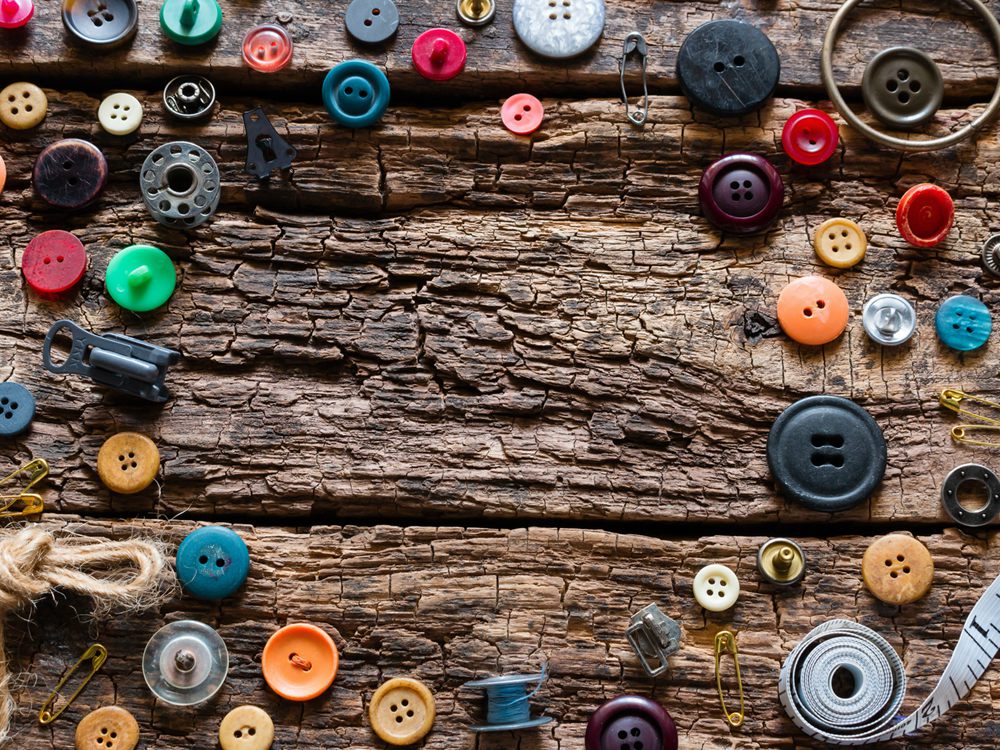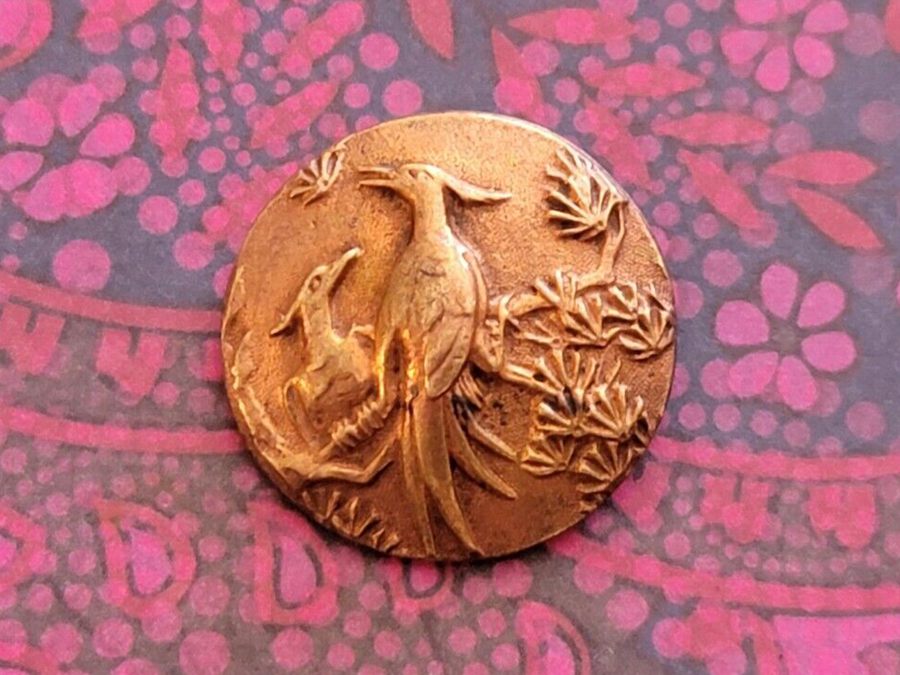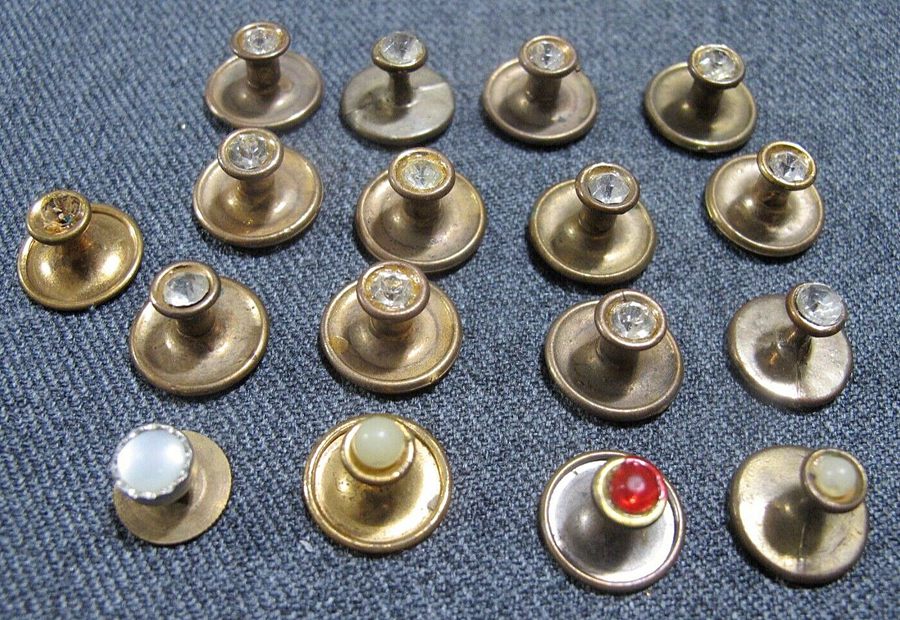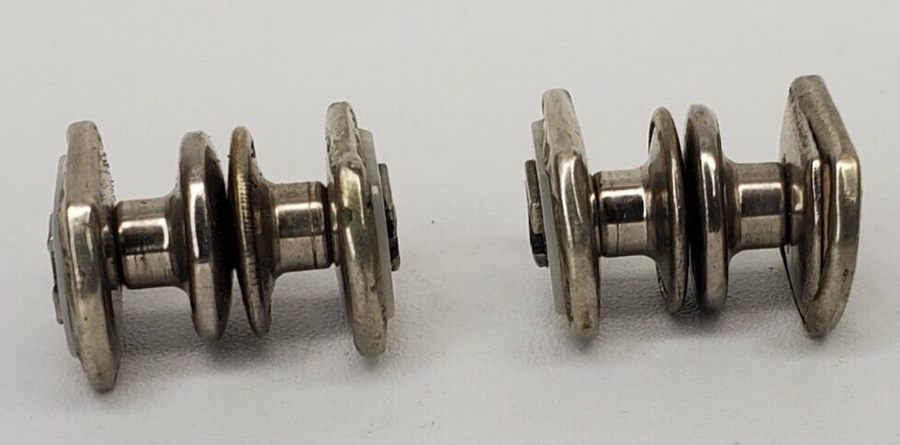Antique buttons have been treasured by collectors for generations. These small and often intricately designed pieces can hold a surprising amount of history, making them an interesting and rewarding hobby for enthusiasts. With buttons made from a variety of materials, such as bone, metal, glass, and wood, you’ll find an array of options to suit your tastes and preferences.
To start your journey into the world of antique buttons, it’s essential to familiarize yourself with the different types available. Flat, shank, stud, snap, and toggle buttons are commonly found in the market, with stud and shank buttons offering a more ornate and valuable option. Keep an eye out for handmade, Victorian, or Art Nouveau designs to ensure your collection holds value.
Identifying the age and origin of an antique button is key to understanding its value. Look for details such as patent numbers, trademarks, and brands to help determine the button’s age. Remember, strictly speaking, a button must be 100 years old to be considered antique. As you explore this fascinating world of vintage and antique buttons, you’ll undoubtedly develop an eye for the rare and valuable pieces, further enhancing your collection and appreciation for these tiny treasures.
Table of Contents
The History & Evolution of Antique Buttons
In the early days of button-making, buttons were more than just a functional fastener. They served as a symbol of wealth and fashion. In the 13th century, your ancestors primarily used buttons as decorative elements made from expensive materials such as bone, horn, and ivory. As time progressed, the function and materials used in buttons evolved.
During the 18th century, different types of materials started to gain popularity, such as brass, copper, and silver. This period also saw the rise of porcelain buttons, which offered a canvas for detailed and intricate designs. As you explore antique buttons from this era, you will notice that these buttons often depicted scenes from nature, mythology, or symbols of power and prestige.
Throughout the 19th century, industrialization led to a wider variety of button materials and designs. Some common materials during this era include:
- Glass: Faceted and molded, your antique glass buttons can feature detailed patterns and striking colors.
- Celluloid: Known as one of the first synthetic plastics, celluloid allowed button-makers to create intricate and affordable designs.
- Metal: Victorian-era metal buttons often boasted ornate designs, including pictorial and floral motifs.
During the 20th century, the production of buttons became more streamlined and mass-produced, which caused manufacturers to create less intricate pieces. However, the early years of the century still produced artistic and collectible buttons, such as Bakelite and early plastic designs.
When identifying and valuing antique buttons, consider factors like material, age, design, and rarity. Unique shapes or designs, as well as any maker’s marks, can contribute to the overall value of a button. As you examine antique buttons, it’s important to remember their historical context and the ingenuity that went into their creation, making each piece a unique and valuable treasure.
How to tell if Button is Antique or old
To determine whether a button is antique or old, pay attention to its material, style, and manufacturing techniques. Here are some steps to help you identify the age of your button:
1. Examine the material
Study the button’s material and check for unprocessed materials in or around the shank or buttonholes. If you see signs of natural color inside, it may indicate that the button was dyed before the holes were made, which is more common in antique buttons.
2. Check for uniformity
Old buttons often lack uniformity due to being handmade. If your button has handmade edges and natural carvings, it might be from the 1700s or even earlier. Look for crude hammered or stamped finishes as well.
3. Look for specific styles
Buttons that display antique styles, such as Art Nouveau or Art Deco, often provide strong clues about their age. Observe the button’s design and compare it to well-known historical styles.
4. Inspect the back
The back of an antique button typically differs in texture from the front, and it may display signs of being handmade, such as a lack of uniformity. Look for any mold lines, as their absence may indicate that the button was not machine manufactured.
5. Use the hot water smelling test
Run the button under hot water and then smell it. If it smells like mothballs or Vicks Vapor, it could be made of celluloid. Bakelite buttons will emit a formaldehyde odor, while lucite buttons won’t have any smell. This can help you identify the material and, consequently, the age of your button.
Remember that determining the age of a button involves careful examination and research. Don’t hesitate to consult a button collector or dealer if you need more specialized assistance.
Types of Antique Buttons
Material-Based
Antique buttons come in various materials, each with its unique characteristics and history. Some of the popular materials used to create buttons are:
- Celluloid: A type of early plastic made from cellulose and camphor. It was commonly used for buttons in the late 19th and early 20th centuries.
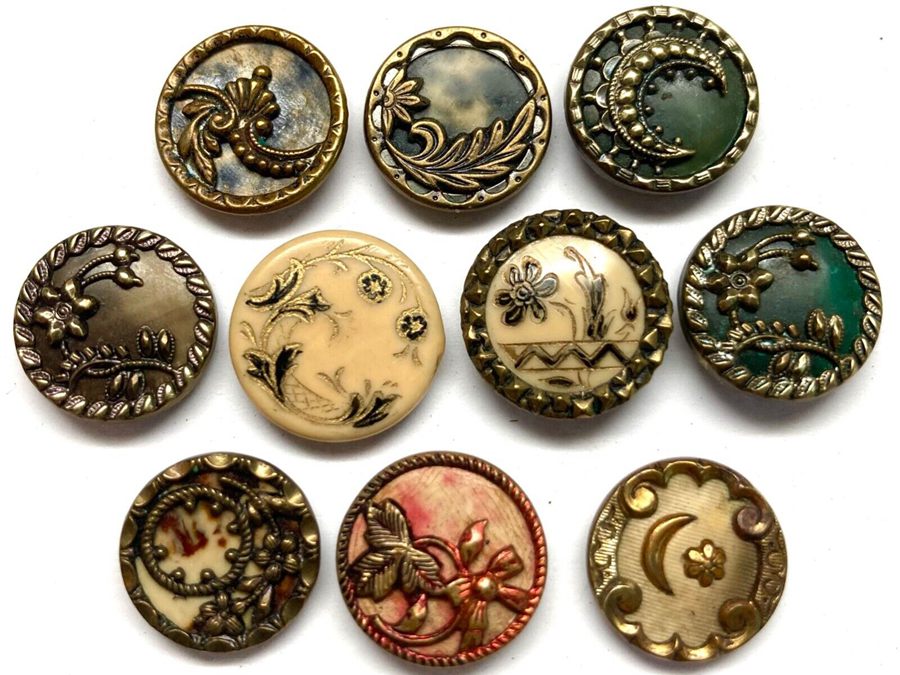
- Bakelite: The first synthetic plastic, invented in the early 20th century, and used extensively for buttons during the 1920s and 1930s.
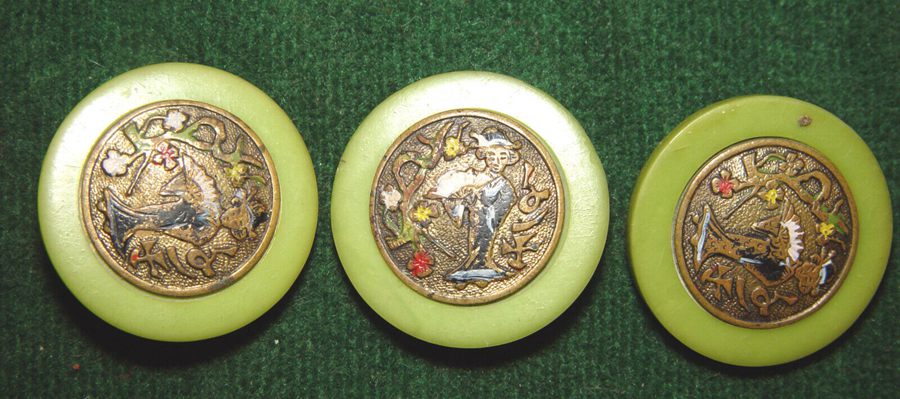
- Lucite: A transparent acrylic plastic developed in the 1930s, often used for buttons as well as other fashion accessories.
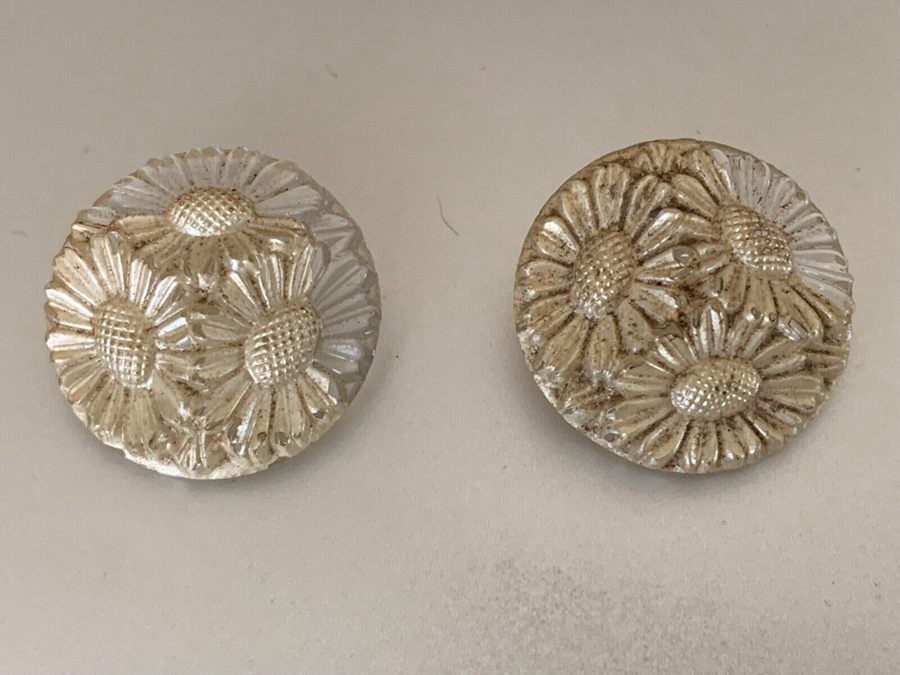
- Vegetable ivory: Made from the hard, dense seed of the tagua palm, this material was used for buttons as an alternative to elephant ivory, especially in the 19th century.
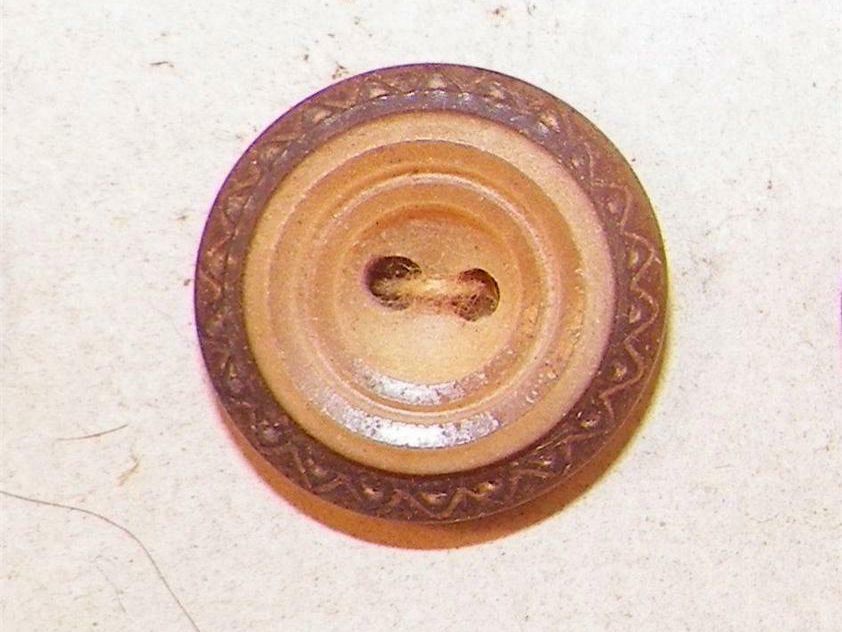
- Metal: Many antique buttons were made from various metals like brass, copper, silver, and even gold. Metal buttons can feature intricate designs and sometimes have gemstones or enamel details.
- Glass: Glass buttons were popular in the 19th and early 20th centuries, offering a range of colors and designs.
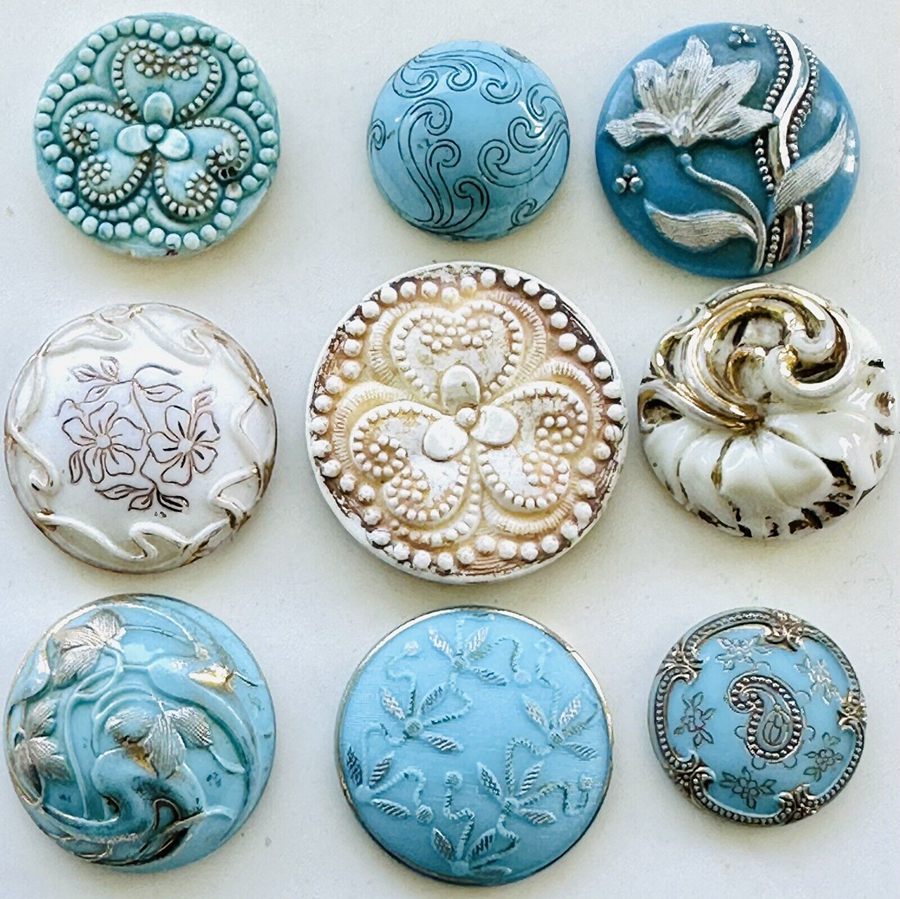
- China: These are ceramic buttons made from materials like porcelain, often featuring intricate hand-painted scenes or patterns.
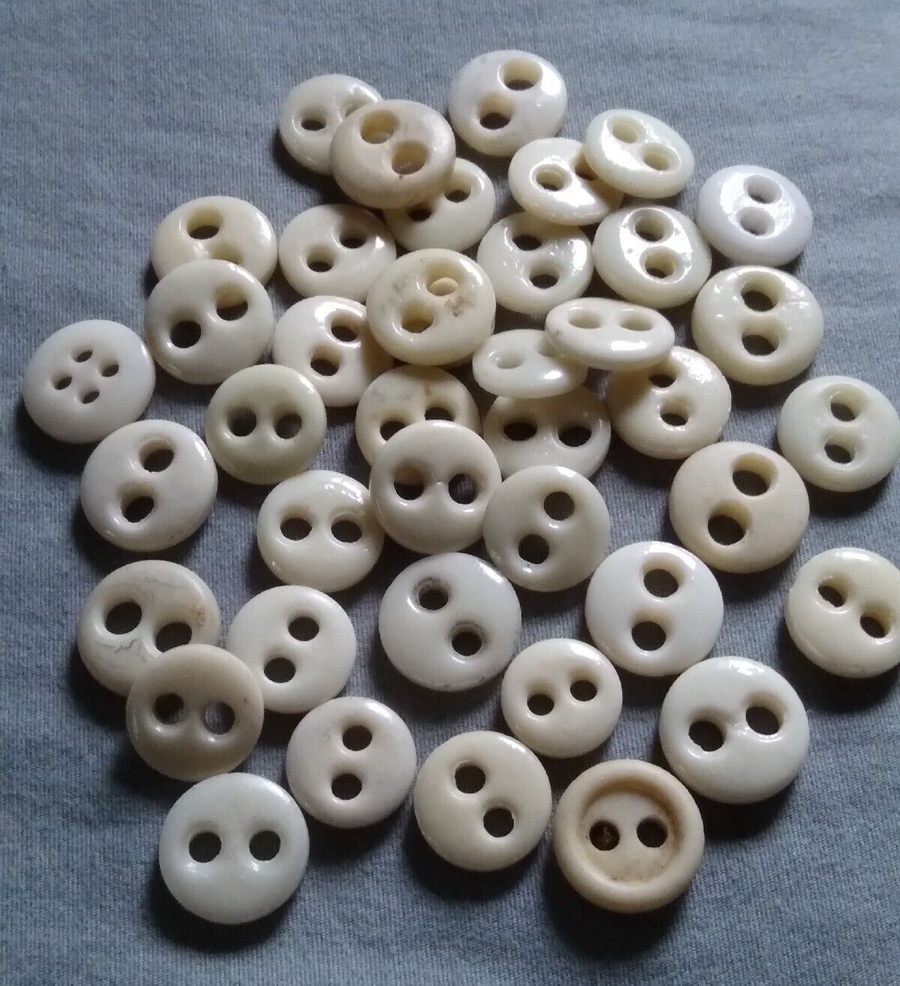
- Mother of pearl: Made from the iridescent inner layer of certain mollusk shells, mother of pearl buttons were valued for their natural beauty and were widely used in the 19th century.
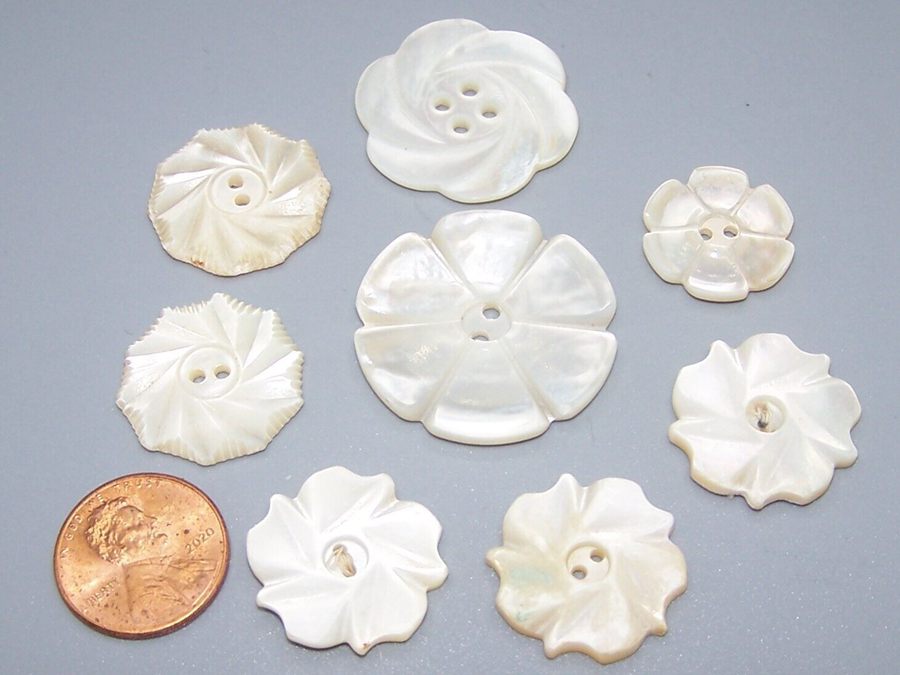
- Bone: Buttons have been made from animal bone for thousands of years, and antique bone buttons can feature a wide array of designs and styles.
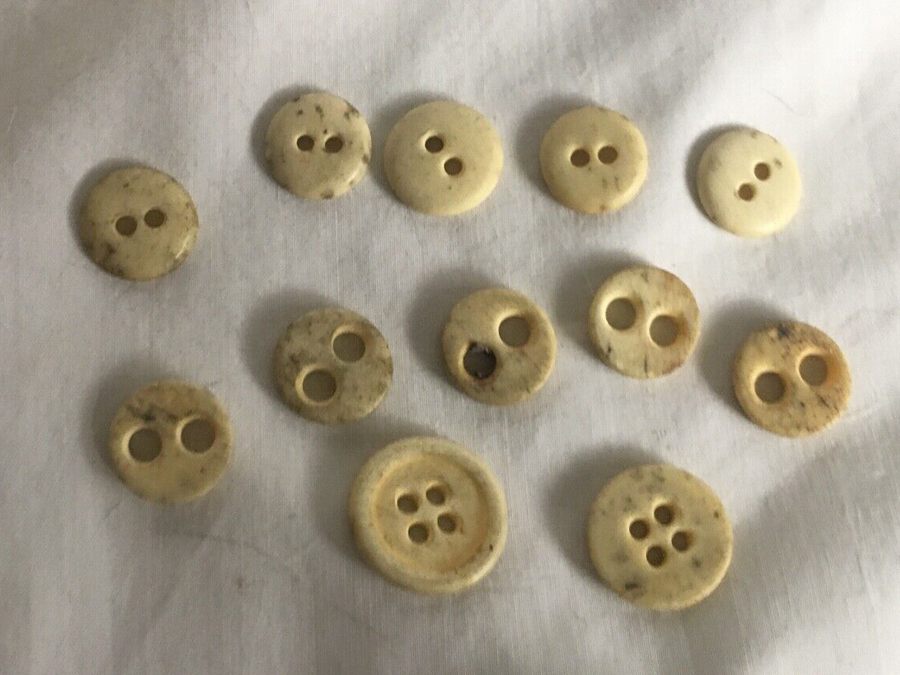
- Fabric-covered: These buttons are made by covering a button blank with a piece of fabric, offering a coordinated look with the garment it was sewn onto.
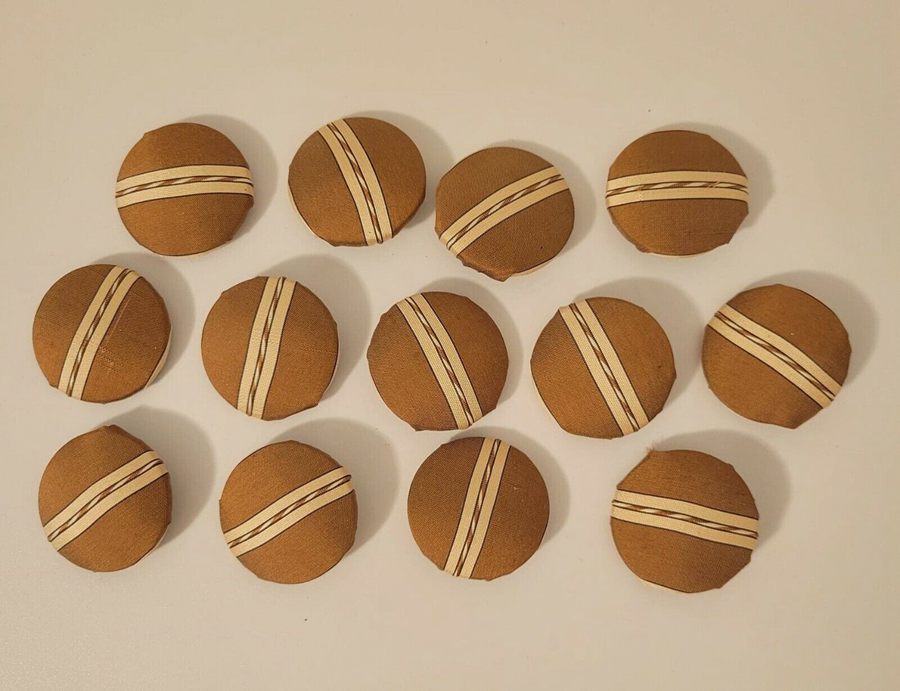
Design-Based
Several design elements can help you identify the age and value of antique buttons:
- Flat buttons: This is the most basic button type, simply consisting of a flat disk with holes for attaching to a garment.
- Shank buttons: These buttons have a loop or shank on the back that allows them to sit slightly away from the garment, making them easier to button and unbutton.
- Stud buttons: Often used for formal wear, these buttons have a separate piece that fits through the garment and into the back of the button, holding it in place.
- Snap buttons: Popular in the early 20th century, snap buttons comprise two parts that click together to fasten a garment.
- Toggle buttons: A more decorative option, toggle buttons are typically elongated and can be made from various materials. They often feature intricate designs and were popular in the Victorian and Art Nouveau eras.
When you’re examining your antique buttons, pay attention to the details such as patent numbers, trademarks, and brands. These clues can help you determine the age and value of your antique buttons. Keeping this information in mind will enable you to build a fascinating and valuable collection.
8 Factors to Identify & Value Antique Buttons
1. Age
The age of antique buttons can significantly impact their value and appraisal. Buttons that are at least 100 years old are considered antique, while those produced after 1920 are generally categorized as vintage. In this section, we will explore how the age of a button can affect its value and provide a valuation table based on the age factor.
Before we proceed with the valuation table, it’s essential to know how to identify the age of a button. You can track a button’s age by searching for its patent number, trademark, and brand on its back, box, or packet. Additionally, some old buttons may have specific materials, styles, or unique features that can hint at their age.
Here is a table showcasing the average valuation based on age:
| Age of Button | Average Valuation |
|---|---|
| Pre-1800 | $10 – $30 |
| 1800-1850 | $5 – $20 |
| 1851-1900 | $3 – $15 |
| 1901-1920 | $2 – $10 |
| Post-1920 (Vintage) | $1 – $5 |
Please note that these valuations are only average estimations and can vary depending on other factors such as material, rarity, and condition. Ultimately, the older the button, the higher value it usually holds, especially if it falls in the pre-1920 category.
To further enrich your understanding, let’s briefly explore the types of antique buttons and how their age relates to their value:
- Old Flat Buttons: Flat buttons made of materials like metal, glass, or porcelain typically date back to the 18th and 19th centuries. Their age contributes significantly to their appraisal.
- Shank Buttons: Shank buttons are another category that may hold high value depending on their age, with brass picture buttons from the Victorian era being particularly sought-after.
- Stud Buttons: Stud buttons, often made of glass or metal, can also be valuable antique buttons when they date back to the 19th century.
As you examine and assess the value of antique buttons, keep in mind the factors mentioned in this section, especially their age. This knowledge will help guide your appraisal and collection efforts.
2. Material
Antique buttons can be found in various materials, which greatly impacts their value and appeal to collectors. The type of material used can often help in identifying the button’s age and origin. Some of the common materials used in antique buttons include:
- Porcelain or ceramic: These buttons produce a clinking sound when tapped and have a cool, lightweight feel. They often feature intricate designs and are known for their durability.
- Mother of pearl and shell: Iridescent and displaying variations in color, these buttons are made from natural materials and can be highly valued by collectors.
- Wood: Wooden buttons often show visible wood grain patterns and have a lightweight feel.
Here’s a table showing the average valuations for antique buttons based on their material:
| Material | Average Valuation |
|---|---|
| Mother of Pearl | $10 – $50 |
| Glass | $5 – $200 |
| Metal (brass, copper) | $5 – $500 |
| Ivory | $20 – $100 |
| Porcelain/Ceramic | $15 – $250 |
| Bone/vegetable Ivory | $5 – $100 |
3. Brands
When evaluating antique buttons, it’s essential to consider the brand or company that produced them. Some classic brands/companies that have created valuable buttons over the decades include Bonnie Heather Pearls, Diamond Card, Good Wear, Jewel Tone, Joblot, Lavahorn, Le Chic, Lansing, Luckyday, and True Craft. These brands have unique designs and materials, which can significantly impact the value of the buttons.
To help you get an idea of the value of buttons manufactured by these brands, we have provided a valuation table below. Please note that these are average valuations and may differ depending on the button’s condition, rarity, design, material, and other factors.
| Brand | Average Valuation |
|---|---|
| Bonnie Heather Pearls | $200 – $300 |
| Diamond Card | $150 – $200 |
| Good Wear | $120 – $150 |
| Jewel Tone | $90 – $130 |
| Joblot | $100 – $150 |
| Lavahorn | $80 – $120 |
| Le Chic | $150 – $250 |
| Lansing | $100 – $200 |
| Luckyday | $75 – $100 |
| True Craft | $120 – $170 |
4. Unique Designs
Antique buttons often showcase unique patterns and intricate detailing, which contribute to their value. These designs can be engraved, hand-painted, or molded into the buttons themselves. Here are some key design factors that affect value:
| Design Type | Average Valuation |
|---|---|
| Hand-Painted | $40 – $300 |
| Figural/Scenic | $30 – $500 |
| Geometric (Arts & Crafts era) | $25 – $150 |
| Florals or Pictorial | $20 – $200 |
5. Age and Rarity
Older and rarer buttons tend to fetch higher prices in the market. Factors such as the manufacturing process, historical context, and scarcity of the button design can significantly impact value. Keep an eye out for buttons that fall into these categories:
| Age/Rarity Factor | Average Valuation |
|---|---|
| Pre-1900 (Victorian) | $50 – $500 |
| Limited Edition | $100 – $1,000 |
| One-of-a-Kind | $200 – $1,500 |
When appraising your antique buttons, remember these factors to ensure an accurate valuation. Explore and research various styles and materials to better understand your collection and appreciate the art of antique buttons.
6. Size
When identifying and valuing antique buttons, the size of the button can play a significant role in determining its rarity and worth. Size, often referred to in terms of diameter or width, can have a great impact on a button’s appraisal.
In many cases, larger buttons tend to be more valuable due to their unique designs and increased level of craftsmanship. This is especially true for antique buttons made from materials such as glass, mother of pearl, and metal.
Keep in mind the following average valuations for antique buttons based on their size:
| Size of Button | Average Valuation |
|---|---|
| Under 1/2 inch | $1 – $5 |
| 1/2 inch to 1 inch | $5 – $20 |
| 1 inch to 1.5 inches | $10 – $50 |
| 1.5 inches and larger | $25 – $100+ |
It is essential to carefully measure your antique buttons to accurately assess their size and potential value. A measuring tape or a ruler can be used for taking these measurements.
7. Color
The color of antique buttons can play a significant role in determining their value and rarity. Antique buttons come in a variety of colors, made from different materials. Some of the popular materials include glass, bone, leather, celluloid, bakelite, and lucite. Each material has its unique characteristics and colors, which can help in identifying and appraising the value of antique buttons.
The importance of color in antique buttons goes back to the time when they were made. Buttons of vibrant and eye-catching colors were considered special and were typically used in high-quality and elaborate designs. These colorful buttons were often made from expensive materials and required skilled craftsmanship to create, making them sought after by collectors.
Here is a valuation table for various antique button colors:
| Color | Material | Average Valuation |
|---|---|---|
| Red | Glass | $400 – 500 |
| Yellow | Lucite | $350 – 400 |
| Green | Celluloid | $300 – 350 |
| Blue | Bakelite | $450 – 500 |
| White | Bone | $250 – 300 |
| Black | Leather | $200 – 250 |
It is essential to remember that the condition of the button also plays a part in determining its value. Antique buttons with vibrant colors and minimal signs of wear or damage are usually more valuable than those with faded colors or visible damage.
In summary, paying close attention to the color of antique buttons can help you identify the material, age, and rarity of the button. By comparing the color and material of your button with the valuation table, you can get a good idea of its potential value. Whether you’re a collector, a dealer, or simply interested in antique buttons, understanding the impact of color on value will be a valuable tool in your appraisal process.
8. Provenance
When determining the value of antique buttons, provenance plays a crucial role. Provenance refers to the button’s history, including its creation, use, and ownership. Knowing the provenance of a button can greatly impact its value, as collectors often seek buttons with a known or interesting history.
For example, buttons that belonged to a famous person or were part of a historical event may have a higher value than those without a known history. Additionally, buttons from a particular time period or with specific designs may be more valuable due to their rarity or intricacy.
To help you understand the impact of provenance on button valuation, here is a table showing average valuations based on factors related to the button’s history:
| Provenance Factor | Average Valuation |
|---|---|
| Owned by a famous person | $700 – 900 |
| Part of a historical event | $600 – 800 |
| Rare time period or design | $500 – 650 |
| Complete set from a specific collection | $400 – 550 |
| Limited provenance information | $200 – 300 |
| No provenance information | $50 – 100 |
Keep in mind that these valuations are just an estimation and should not be considered definitive. When appraising your antique buttons, consider their provenance along with their age, rarity, and condition to help identify their true value. It’s always a good idea to consult with a professional appraiser or local dealer to get the most accurate valuation possible.
Conclusion
After learning about the different types of antique buttons, identifying them becomes much easier. Remember, there are five main types of buttons: flat, shank, stud, snap, and toggle. Stud and shank buttons tend to be more valuable due to their intricate designs.
To determine the age of your button, look for its patent number, trademark, or brand. Keep in mind that a button must be at least 100 years old to be considered antique. Buttons made before 1920 are generally rarer and more valuable.
Throughout history, buttons have been made from a variety of materials like bone, antler, hoof, minerals, gems, glass, metal, nuts, seeds, shell, wood, leather, and plastics. This large array of materials can make for interesting and unique collections.
When testing for a specific type of material, such as bakelite, you can try methods like running hot water over the button and smelling it for a formaldehyde scent. Alternatively, you can use Simichrome metal polish or 409 All-Purpose Cleaner on a Q-tip and rub it on the button.
In conclusion, developing an understanding of antique buttons can lead to a fascinating and rewarding hobby or even a profitable side-business. As you continue to explore the world of antique buttons, your knowledge and ability to identify and appraise them will grow, making you a true connoisseur in the field.
FAQ
How do I identify bakelite buttons?
To identify a bakelite button, you can run hot water over it and then smell it. It should have the smell of formaldehyde, cod liver oil, or a sweet chemical smell. Alternatively, you can put a bit of Simichrome metal polish or 409 All-Purpose Cleaner on a Q-tip and rub it on the button.
What are some types of old buttons I might find?
As an antique collector, you might come across different types of old buttons. Some of these include:
- Old Flat Buttons: Simple, straight two to four holed buttons.
- Glass Buttons: Made from various types of glass.
- Bone Buttons: Made from animal bones.
- Leather Buttons: Crafted from leather.
- Old Metal Buttons: Made from different types of metals.
How do I determine the age and value of an antique button?
Strictly speaking, a button must be 100 years old to be considered antique. To determine the age and value of an antique button, you should consider its materials, craftsmanship, rarity, and overall condition. You can also consult antique button identification guides and price reference books for additional information.
What are some rare and valuable antique buttons?
Some of the rarest and most valuable antique buttons you might come across include:
- Enamel & 18K Gold Cuff Buttons, valued around $3,900. These handmade cuff buttons, made of a combination of 18k yellow gold and enamel, originated from France between 1819 and 1838.
- Victorian Glass Buttons
- Bakelite Buttons
- Lucite Buttons
Remember that the value of a button can vary depending on its rarity, condition, and the specific market.

